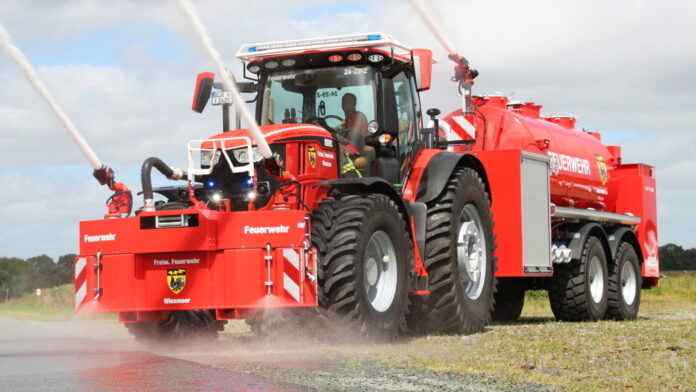In a remarkable shift within emergency response capabilities, a unique transformation has taken place in Wiesmoor, where a John Deere 6R 250 tractor has been repurposed into a firefighting vehicle. This innovative adaptation combines agricultural efficiency with advanced firefighting technology, showcasing the potential for cross-industry collaboration. With a staggering 301 horsepower and equipped with a 12,000-liter tank, this vehicle is set to redefine the standards of fire response in rural areas. As communities face increasing threats from wildfires and other emergencies, how can such advancements impact safety and operational efficiency?
The stakes are high as municipalities grapple with the challenges posed by climate change, which has led to an uptick in the frequency and intensity of fires. Traditional firefighting vehicles often fall short in rural settings, where access to water and rapid deployment are critical. This innovative tractor not only addresses these concerns but also offers a cost-effective solution for local fire departments. As the need for rapid response grows, can this new approach serve as a model for other regions facing similar challenges?
A Revolutionary Approach to Firefighting
The integration of a tractor into firefighting operations represents a significant evolution in emergency response. This John Deere 6R 250 has been meticulously modified to include three powerful water cannons, making it capable of delivering high-pressure water streams directly to fire sites. This adaptation allows firefighters to tackle blazes more effectively, especially in areas where traditional fire trucks may struggle due to terrain or water access limitations. The vehicle’s robust engine and large tank capacity ensure that it can sustain operations for extended periods, which is crucial during prolonged firefighting efforts.
Moreover, the tractor’s versatility extends beyond firefighting. Its design allows for easy maneuverability across various landscapes, making it suitable for agricultural tasks when not in emergency use. This dual functionality not only maximizes investment but also enhances the overall utility of the vehicle within the community. The ability to seamlessly transition between agricultural and emergency roles can lead to improved resource management and cost savings for local governments.
As rural areas continue to face unique challenges in emergency preparedness, the implications of this innovative approach extend far beyond Wiesmoor. Other municipalities may look to replicate this model, potentially leading to a widespread transformation in how rural fire departments operate. The success of this tractor conversion could inspire further advancements in emergency vehicle design, encouraging collaboration between agricultural and firefighting sectors.
Cost-effective Solutions for Rural Fire Departments
The financial implications of this transformation are noteworthy. Traditional firefighting trucks can be prohibitively expensive, often costing hundreds of thousands of dollars. In contrast, repurposing existing agricultural machinery can significantly reduce costs while still enhancing firefighting capabilities. The investment in modifying a tractor, while still substantial, is a fraction of what municipalities would typically spend on new firefighting equipment. This cost efficiency is particularly appealing to smaller fire departments operating on tight budgets.
Furthermore, the operational costs associated with maintaining a tractor are generally lower than those of specialized firefighting vehicles. With fewer mechanical complexities and more readily available parts, rural fire departments can allocate their budgets more effectively. This financial flexibility allows for improved training, better equipment, and enhanced community outreach programs focused on fire prevention and safety.
As local governments seek innovative solutions to meet budget constraints, the success of this tractor adaptation may prompt increased interest in similar projects. The potential for cost savings, combined with enhanced firefighting capabilities, could lead to a paradigm shift in how rural fire departments approach their operational strategies.
Enhancing Community Safety and Preparedness
Community safety is at the forefront of the discussion surrounding this innovative tractor conversion. With the increasing frequency of wildfires and other emergencies, the ability to respond quickly and effectively is paramount. The 12,000-liter tank allows firefighters to access a substantial water supply, enabling them to combat fires at their onset, which is crucial for minimizing damage and protecting lives.
Moreover, this initiative fosters a sense of community resilience. By investing in local resources and adapting existing equipment, fire departments can strengthen their ties with the community they serve. This collaboration can lead to increased public awareness regarding fire safety and preparedness, encouraging residents to take proactive measures in fire prevention.
As communities observe the effectiveness of this new firefighting strategy, it may inspire further innovations in emergency response. The success of this project could lead to a ripple effect, prompting other regions to explore similar adaptations and investments in community safety. The potential for enhanced preparedness and response capabilities could significantly alter the landscape of rural firefighting.
The Future of Emergency Response in Rural Areas
The transformation of the John Deere 6R 250 into a firefighting powerhouse marks a pivotal moment for rural emergency response. As this model gains recognition, it may encourage further exploration of unconventional solutions to longstanding challenges in firefighting. The blending of agricultural machinery with emergency response capabilities opens new avenues for innovation, prompting a reevaluation of how resources are allocated in rural settings.
Looking ahead, the implications of this project extend beyond Wiesmoor. As rural communities face an evolving landscape of threats, the need for adaptable and efficient emergency response systems becomes increasingly critical. This tractor conversion could serve as a blueprint for future initiatives, encouraging municipalities to think creatively about resource utilization and community safety.
Ultimately, the success of this project underscores the importance of collaboration between sectors and the need for innovative thinking in addressing modern challenges. As rural fire departments continue to adapt and evolve, the potential for improved safety and preparedness remains bright, paving the way for a more resilient future.


